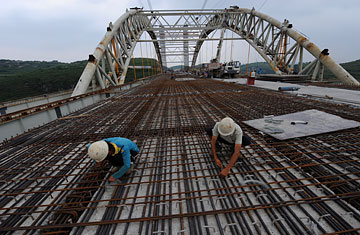
Workers at the site of a new bridge in Guiyang of Guizhou province, China, on June 20, 2009
If numbers alone tell the story, then China appears to have beaten the odds. It has apparently shrugged off the worst global recession in at least 30 years — one that had, at the end of last year, crippled growth in a country for which exports are a critical part of its economic lifeblood. The government responded by announcing a $585 billion spending package, driven by massive infrastructure investments across the country, and, for now anyway, that policy is paying off. China announced today that its GDP in the second quarter grew at 7.9%, just a shade below the 8.1% goal the government set for growth in 2009. "The strong acceleration in underlying economic activity is now unmistakable," says Yu Song, a Goldman Sachs economist based in Hong Kong.
That acceleration — GPD growth was just 6.1% in the first quarter — is unmistakably good news for China's major trading partners, particularly those countries in Asia that export raw materials to China's manufacturers. Imports of semifinished industrial metals in the quarter soared by more than 35%, as China's stimulus-driven infrastructure build-out gathered steam. Overall fixed-asset investment picked up 33.5% year over year, a pace that recalled the country's glory years of double-digit economic expansion.
Much of that investment growth came from the brute force of the government, which is directing bank loans to state-owned companies, which in turn have been building everything from high-speed rail networks to new highways and bridges across China. But economists were quick to note that other sectors of the economy besides construction now seem to be joining the party. In particular, property investment rose by nearly 18% in the quarter, well above what many economists had expected.
To analysts still skeptical of China's recovery story, major questions hung over the announcement today. One concerns long-standing doubts about the reliability of government economic data — what one U.S. hedge-fund manager calls "the Beijing fudge factor." In the first quarter of this year, Beijing reported 6.1% GDP growth, but electricity consumption overall in the country appeared to decline. How a country the size of China could grow by 6% yet use less electricity was puzzling. And in the first six months of this year, overall rail-freight traffic declined in China. Again, how that squares with accelerating growth is not clear.
But today's report also offered some reassurance that perhaps the fudge factor isn't that big an issue. Electricity generation snapped back sharply in the second quarter, statistics show. Some analysts believe the drop late last year and early in 2009 was consistent with an economy in which heavy users of power, such as steel and aluminum factories, were slashing production is response to weakened global demand. Now, China's aggressive government spending has refired the furnaces.
Andrew Barber, Asia strategist for Research Edge, an equity-research firm based in New Haven, Conn., believes Beijing's National Bureau of Statistics "well understands that there are doubts in the markets about the reliability of China's data. But unlike a year ago, they are actively trying to take baby steps toward more transparency." Government statisticians recently announced that they would work with the Organization for Economic Cooperation and Development to improve data quality.
The bigger issue that divides economists is whether China's growth spurt is sustainable. Goldman Sachs and several other major investment banks are increasing their China growth forecasts for the rest of this year and into 2010. Strong retail sales and household-survey data show that consumption is contributing to growth and may help sustain it even if government spending levels off.
Others remain unconvinced, viewing China, in effect, as an economy on steroids. Bank-lending numbers announced last week showed an extraordinary leap. New loans in June totaled the equivalent of $224 billion, more than double the previous month's lending. The total amount of money that banks have loaned thus far in 2009 already exceeds the total amount loaned for all of last year. Speculative froth in China's financial markets abounds. Long-futures interest on copper contracts on the Shanghai Metals Exchange — bets that the price of copper will continue to rise — recently exceeded the total amount of copper delivered into China in 2008. Research Edge's Barber believes Beijing is buying current growth at the expense of the future. Politically, he acknowledges, Beijing's leadership may not have had any other realistic choice when the developed world collapsed last fall. "But I have no doubt there will be pain down the road" because of the lending binge, he says.
When that pain will come, and how intense it may be, is still anyone's guess. For the moment, at least, China is again growing smartly — and that's more than much of the rest of the world can say.
